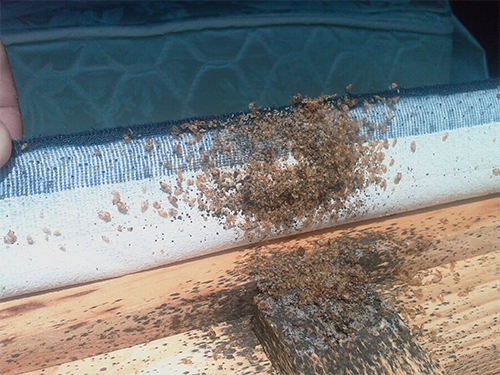Expert Bed Bug Exterminator: DC Solutions and Heat Treatment
Expert Bed Bug Exterminator: DC Solutions and Heat Treatment
Blog Article
Exploring the Scientific Research Behind Bed Insect Warmth Treatments as a Sustainable Pest Monitoring Technique
One such technique that has actually gained traction in recent years is the usage of warmth therapies to combat bed bug infestations. The ins and outs of just how warmth properly eliminates bed bugs and the wider ramifications for lasting parasite monitoring techniques make this a subject worth discovering further.
Bed Bug Heat Treatment Process

Thermal Fatality Point for Bed Pests
Subjecting bed pests to elevated temperature levels beyond their thermal tolerance variety is essential for attaining effective obliteration in heat therapy procedures. The thermal death factor for bed bugs describes the temperature level at which these insects can not endure. Research suggests that bed insects begin to perish when subjected to temperature levels above 113 ° F(45 ° C) for a continual duration. As the temperature increases, so does the mortality rate of bed bugs. At around 118 ° F(48 ° C ), bed bugs start to die swiftly, with a mortality price of virtually 99% within minutes of exposure. This shows the level of sensitivity of bed bugs to high temperature levels and highlights the effectiveness of warm therapies in eradicating invasions. By getting to and keeping temperatures above the thermal death point for bed insects, parasite management experts can make sure thorough removal of bed bug populations, including hard-to-reach locations where chemical therapies might be much less reliable. Comprehending the thermal fatality factor for bed pests is essential for executing successful warm treatment methods and accomplishing sustainable bug administration end results.
Benefits of Warm Treatments
Having actually developed the essential thermal death point for bed bugs, it is essential to currently check out the considerable benefits that heat therapies use in efficiently eradicating these resilient parasites. Warmth therapies present numerous essential advantages when compared to traditional chemical approaches. Among the primary benefits is that heat can pass through deep into splits and crevices where bed insects conceal, guaranteeing that also the most hard-to-reach locations are heated to deadly temperature levels. This detailed technique not only eliminates real-time insects yet also targets bed insect eggs, preventing future infestations.
Furthermore, heat treatments are environmentally friendly and non-toxic, making them a lasting bug monitoring strategy. Unlike chemical pesticides, warmth treatments do not leave dangerous deposits that can posture risks to human health or the environment. This aspect is particularly crucial in delicate settings such as health centers, schools, and suburbs where chemical use may not be desirable.
Additionally, heat therapies have a high success price in removing bed pest problems in a solitary treatment, decreasing the demand for numerous brows through and minimizing disruption to owners. This performance not only saves time and money yet additionally supplies assurance to those taking care of bed insect problems.
Effectiveness of Heat Therapy

Research study studies have actually regularly shown the efficiency of warmth treatments in attaining a high rate of bed bug death. Correctly performed warm therapies can reach all the holes and splits where bed bugs might be harboring, making sure a comprehensive technique to extermination. In addition, warm therapies have the included benefit of eliminating bed bug eggs, which are usually resistant to typical chemical treatments. In general, the performance of heat treatments in removing bed bug invasions makes them a trusted and sustainable parasite management method.
Lasting Parasite Management Benefits
Implementing sustainable insect management practices supplies lasting benefits for both the environment and public health. By making use of approaches such as warmth therapies for bug control, we can minimize the reliance on hazardous chemical pesticides that can have adverse results on ecological communities and human health and wellness - DC exterminator. Lasting bug administration techniques help in protecting biodiversity by targeting specific insects without damaging non-target organisms, therefore preserving a balanced ecological community
Additionally, sustainable insect monitoring methods contribute to the total health and health of the general public. By lessening exposure to hazardous chemicals used in Get More Info typical insect control approaches, heat therapies supply a safer option for pest administration in residential, industrial, and public rooms. This reduction in chemical use also aids in stopping chemical residues from polluting soil, air, and water, safeguarding ecological top quality.
Final Thought
To conclude, bed Go Here bug warm therapies have actually been shown to be a effective and sustainable insect administration approach. The thermal fatality point for bed bugs makes them prone to warmth therapies, which have many benefits over traditional chemical treatments. The efficiency of warm therapies in removing bed pest infestations while reducing ecological influence highlights the potential of this method as a sustainable service for bug control.
The bed insect warmth therapy procedure entails elevating the temperature within ravaged locations to a degree that properly removes bed pests and their eggs. By getting to and keeping temperature levels over the thermal fatality factor for bed insects, bug administration experts can make sure detailed removal of bed insect populations, consisting of hard-to-reach locations where chemical therapies might be less effective. One of the primary advantages is that warmth can pass through deep into cracks and crevices where bed insects hide, guaranteeing that even the most hard-to-reach locations are warmed to deadly temperatures. Unlike chemical treatments that may leave behind immune populaces, warm treatments supply a safe and ecologically friendly solution that can penetrate click for more deep right into furniture, walls, and various other hard-to-reach areas where bed bugs conceal.
The thermal death factor for bed insects makes them vulnerable to heat therapies, which have various advantages over typical chemical treatments.
Report this page